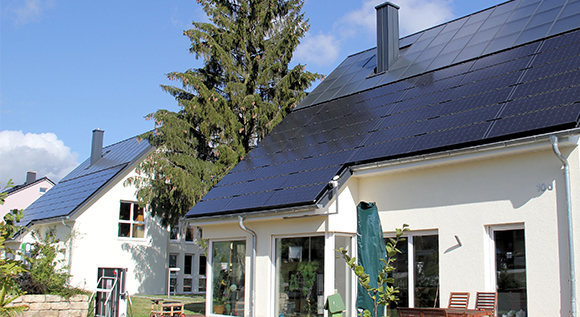Solar construction and a secure supply of energy
Climate-neutral buildings by 2050 – research into energy-efficient and solar houses and cities given a boost.
 © Timo Leukefeld
© Timo Leukefeld
To turn on the heating or not to turn on the heating. This is a common dilemma we face in April. But we should not have to suffer from a guilty conscience if we opt for 'on'. After all, researchers up and down the country are working hard to make our heating systems and building envelopes more efficient, to better integrate renewables in our energy system, and to bring down our energy consumption. As of this week, there is now even more support available for this work.
Mitigating climate change and improving energy efficiency...
Large amounts of energy are still being wasted in buildings in Germany. Our homes account for almost 35 per cent of our final energy consumption, and most of it is used to provide heat and hot water. We want this to change. The Federal Government has recognised this as an area that offers major potential for efficiency and set out the target of making all of Germany's buildings virtually climate-neutral by 2050. This means that they are to emit hardly any carbon dioxide at all.
... within individual buildings ...
Research can help us achieve this. Let's take the example of someone building a new home. They can increasingly rely on the sun for their energy supply. Modern facades that convert daylight into heat can reduce the need for additional heating – and they also look good. This new technology is called 'solar construction'.
Researchers in Saxony are currently testing a type of house that combines insulation and the use of solar energy. The windows have been designed to make the most of the daylight that is available and of the heat contained in it. The roofs that are facing south are pitched at a sharp angle and have solar panels and modules fitted. These supply the house with both heat and electricity, which can be stored within the building for several days.
... and across entire cities
But if we are to make our entire building stock virtually climate-neutral by 2050, we also need to think beyond individual homes. We have to target entire cities as well. Roughly 75 per cent of our population live in urban areas, and even some of the most elegant neighbourhoods have buildings that waste a great deal of energy. This is why we need to make urban energy systems fit for a more energy-efficient future.
Ludwigsburg is leading the way with its new Sonnenberg neighbourhood and Grünbühl, a neighbourhood built in the post-war years that is now in urgent need of modernisation. The city is in the process of linking up the two places using an innovative energy system. The newly constructed neighbourhood is supplied with heating energy from heat pumps and from a CHP unit. The heat generated there is also supplied to the nearby Grünbühl neighbourhood via a large district-heating network. As a result, the residents of Grünbühl benefit from a higher quality of life and lower heating bills.
Support for ideas for 2050
The Federal Government has launched a new initiative to fund innovation around solar construction and energy efficiency in cities. Under the 'solar construction/energy-efficient cities' initiative, the Federal Ministry for Economic Affairs and Energy and the Federal Ministry of Education and Research are now providing 150 million euros for this purpose. On top of this, the Federal Ministry for Economic Affairs and Energy is providing another 35 million euros to be spent on ground-breaking pilot projects designed to speed up the process of translating research findings into marketable solutions ('EnEff:Buildings2050' programme).
Introducing the research initiative, State Secretary Rainer Baake said: "The research initiative provides an important basis for networking between the stakeholders involved in the energy transition as far as buildings are concerned. Its main purpose is to ensure that demographic change and its implications and the issue of sustainable and affordable living are part of the discussion alongside the technical aspects of the energy transition. We want to use an overarching approach as we develop solutions for energy-efficient buildings and cities for the future."
Translating ideas into practice
What may sound highly complex really is just another logical step. Many a research project that had a futuristic ring to it only a while ago is now ready for technical application. All it takes is a bit of help to get these projects off the ground, so new funding mechanisms are to be used to translate R&D results into practice.
Up until 27 July 2016, researchers looking for ways to make our buildings and cities more energy-efficient can apply for funding under the 'solar construction/energy-efficient cities' initiative. Ideally, we are looking for consortia uniting researchers and practitioners, for instance SMEs that have teamed up with universities or research institutes.
This is how consumers can benefit
But the science community is not the only one who can help us make our buildings virtually climate-neutral by 2050. Home owners who modernise their building and bring it in line with the current state-of-the-art of energy efficiency can reduce their energy consumption by up to 80 per cent, which, for a single-family home, translated into savings of an average of 675 euros on heating bills last year. Having your home participate in the energy transition is good for the climate – and it will also make your home more comfortable and increase the value of your property.
An energy-efficient house needs a modern and highly efficient heating system – ideally one that provides renewable heat from solar energy, biomass, ambient heat or geothermal energy. It is also worth thinking about having an efficient ventilation system fitted. The Federal Ministry for Economic Affairs and Energy provides support to home owners who want to start using renewable heat.

